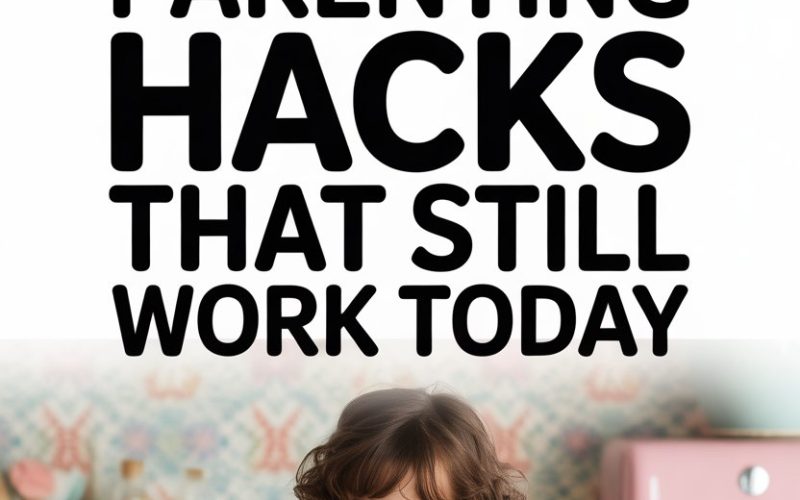Raise your hand if you ever hid veggies in a casserole, gave your child a “boredom box,” or survived a road trip without a screen.
Ah, the ‘90s—a simpler time when you could lose your kid at Blockbuster for a solid ten and nobody batted an eye.
While technology marches on and parenting books multiply faster than socks in a tumble dryer, plenty of old-school hacks still outclass modern trends.
For the parents spinning plates between work, errands, and those “urgent” requests to watch another slime tutorial on YouTube—here’s a nostalgic toolkit with staying power.
Snack Bins: Toddlers, Teens, and Everyone In-Between
Busy households in the ‘90s didn’t have snack subscriptions or fridge doors full of pre-cut organic mango. Parents tossed an odd mix of raisins, crackers, and cheese into a plastic tub, called it the “snack bin,” and left it within reach.
This hack is a lifesaver for the after-school feeding frenzy, but it’s just as practical now. A box or basket filled with sensible snacks can set boundaries, cut down on whining, and teach self-regulation.
No need to get fancy—bulk popcorn, dried fruit, and a few “treats” do the trick. Even older kids appreciate the autonomy (and you’ll spend fewer minutes refereeing the fridge).
The Boredom Buster Jar: Because “I’m Bored” Is Timeless
Nothing says “parenting rite of passage” like the phrase “I’m bored.” ‘90s parents had a clever retort: the boredom jar. A mug, an old jam jar, or even a shoebox filled with slips of paper—each with an activity suggestion.
Yes, some will be met with groans (hello, “clean your room”). Yet the magic is in the randomness. Choices can range from “draw a comic strip” to “build a fort” or “write a letter to grandma.”
The trick? Include a couple of chores for good measure. Suddenly, reading a book looks a lot more appealing.
DIY Chore Charts Get Stuff Done
Magnetic whiteboards, sticker charts, or a paper tacked to the fridge—whatever your weapon of choice, visual chore charts are a ‘90s staple that still manage to inspire effort (and the occasional sibling rivalry).
Kids love ticking boxes. Parents love seeing beds made and socks paired up. For teens, try swapping stickers for privileges—like extra WiFi time or picking movie night.
Psychologists back up this approach: visible goals bolster motivation and help kids grasp responsibility. Turns out, a little accountability never goes out of style.
No-Screen Zones: The Dinner Table Still Matters
Back when “screen time” meant one blocky set in the lounge, family meals were sacred. The dinner table remains a top spot for connection, conversation, and—let’s face it—negotiating how many peas count as “enough.”
Declaring certain spots or hours screen-free isn’t easy, but it works wonders for family bonds and healthier eating habits, according to numerous studies on screen-free mealtimes.
You might get a few groans or some Olympic-level eye-rolling, but you’ll also get stories, giggles, and maybe a glimpse into their TikTok-free personalities.
Handwritten Notes: A Low-Tech Boost for Big Emotions
Lunchbox notes: Possibly the most heart-melting hack of the ‘90s. A silly drawing, a joke, or a “good luck” scribble on a napkin can brighten even the most Monday-esque Monday.
Turns out, these little surprises still work their magic. Experts highlight that notes from home help reduce anxiety and boost resilience—especially during times of transition.
Tuck one in their backpack, pencil case, or under their pillow.
The message? You’re thinking of them, even when you’re not physically there.
One-on-One Time—Quality Over Quantity
Between jobs, sports, and the Sisyphean task of laundry, carving out time for each child is no mean feat.
Parents in the ‘90s managed it with mini-rituals: a weekly walk, bedtime chat, or special breakfast.
Research on attachment backs this up—kids don’t need endless hours, but regular pockets of attention help them feel seen and secure.
Even ten minutes before bed, reading a shared book or asking about their day, can work wonders. No need for Pinterest crafts or elaborate outings.
“Go Play Outside” Still Works—Promise
No WiFi? No problem. Sentencing kids to the backyard (or local park) remains the gold standard for burning off energy and boosting creativity.
Outdoor play is linked to better focus, stronger mental health, and more robust immune systems. If you’re lucky enough to have a safe space, send them out with a ball or a skipping rope and see what unfolds.
Sometimes, the absence of structure breeds the best adventures.
Reward Coupons: The Currency of Childhood
Every ‘90s kid remembers the thrill of “get out of chores free” cards or the promise of ice cream for a week’s worth of good behaviour. Homemade reward coupons still appeal to kids’ sense of agency (and, let’s be honest, your parenting sanity).
The beauty is in the flexibility: rewards can be experiences, treats, or privileges—think “choose dinner,” “pick the playlist,” or “movie night boss.”
Behaviour specialists still recommend tangible rewards as short-term motivators, especially for younger kids learning new routines.
The Car Kit: Because Parenting Happens Everywhere
Before anyone uttered the phrase “car organisation hack” on Instagram, every ‘90s parent had a battered tote stashed in the boot: wipes, snacks, a change of clothes, plastic bags, and a rogue action figure.
A stocked car kit is still your best mate for unpredictable messes, impromptu picnics, or emergency “I forgot my trainers!” moments. Modernise it with a phone charger and a few more snacks (because someone’s always hungry).
Staggered Bedtimes—Peace and Quiet, By Design
Siblings winding each other up as the sun sets? Welcome to the club. Parents in the ‘90s knew that giving each kid their own bedtime routine—ten or fifteen minutes apart—reduced the chaos and allowed for individual attention.
This trick is especially handy for families with multiple kids close in age. The youngest gets their story, the middle child gets a cuddle, and the eldest gets some chat time.
Bedtime becomes more peaceful, and you get a few precious minutes to yourself—possibly with the TV remote.
Clothes Prep on “Sunday Night”—Still a Sanity Saver
Few things start the week off worse than a Monday-morning wardrobe crisis. ‘90s parents would line up uniforms or outfits for the week on Sunday night—sometimes with colour-coded hangers, sometimes with a prayer.
Current parents can adapt this for all ages—lay out clothes, pack bags, and save the 7 am scramble. Little ones can help pick their outfits (within reason!), while teens can be gently nudged toward “looking like you dressed on purpose.”
The Joy of the Family Calendar—Now With Apps
Walls covered in sticky notes? You’re not alone.
Colour-coded wall calendars were the ‘90s equivalent of a group chat, with everyone’s activities scribbled in for all to see.
If paper’s not your jam, shared digital calendars like Google Calendar or Cozi make it easier to track everyone’s whereabouts.
Each family member gets their own shade, and the double-booking blame game is officially a thing of the past.
The Art of “Good Enough” Meals
Gourmet meals every night? Please. ‘90s parents made peace with cereal for dinner, spaghetti on heavy rotation, and creative casserole experiments.
Nutritionists agree: variety matters more than perfection, and family meals—however basic—do more for kids’ emotional health than perfectly plated quinoa bowls.
Dust off that slow cooker or tray-bake and pat yourself on the back.
Earning Screen Time—the Original Token Economy
Before apps tracked screen time, parents made kids earn their Mario Kart minutes or cartoon fix with completed chores, finished reading, or outdoor play. This hack is still as effective as ever.
Set clear expectations: “Thirty minutes of reading buys you thirty minutes of TV.” Consistency is key. And if you get nostalgic about the old days, that’s just bonus parenting points.
Shoe Bins at the Door—Cleaner Floors, Lower Stress
The ‘90s battle cry: “Shoes off at the door!” Not only does this keep floors cleaner, it also saves those precious seconds spent hunting for a missing trainer during the school rush.
A basket or shelf by the door keeps things organised. For reluctant teens, a friendly wager about who can keep their shoes paired up the longest might just do the trick.
Backup Birthday Gifts—Your Secret Weapon
Every parent knows the horror of the “surprise” birthday party invite. ‘90s parents had a stash of backup gifts—puzzles, books, or classic games—wrapped and ready for last-minute emergencies.
Build a modest stash from sales or multipacks, and you’ll avoid the frantic dash to the shops. For bonus points, keep a stash of cards and gift bags handy. Your future self will thank you.
“You Break It, You Fix It”—Natural Consequences Still Teach
When something precious (or sticky) breaks, ‘90s parents often invoked the old “you break it, you fix it” rule. This isn’t about punishment—it’s about learning natural consequences.
If a toy gets left out in the rain, your child helps clean it up. Spilled juice? Pass the towel.
Child development experts agree: natural consequences are powerful teachers and help kids grow more responsible.
The Road Trip Survival Kit—Screens Optional
Once upon a time, families survived journeys with I Spy, travel bingo, and a bottomless pit of snacks.
The road trip kit—filled with games, music, and a pillow or two—is still unbeatable, even if you allow the odd screen.
Challenge your kids to survive half an hour unplugged, and see what wild stories or questionable singing emerges.
Rainy Day Emergency Box—Sanity in a Shoebox
Any seasoned parent knows that a rainy Saturday can test the limits of patience and creativity. ‘90s parents kept a secret stash of rainy day supplies—old board games, construction paper, playdough, and half a deck of Uno.
Refresh the tradition with simple craft kits, a pack of cards, or new colouring books squirreled away for emergencies. When screens lose their appeal, this box works like magic.
Your Parenting Superpower: Good Enough Is Great
Perfection is overrated; laughter and love are not. The best hacks are the ones that make your day a bit easier and your child’s life a bit happier.
The ‘90s taught us that resourcefulness trumps expensive gadgets, and the classics stick around for a reason.
Next time you’re tempted to reinvent the parenting wheel—or download another tracking app—remember that a well-timed “go outside and play” still holds up.
And if you’re ever caught singing a boy band hit while packing lunches, congratulations: You’re doing it right.





